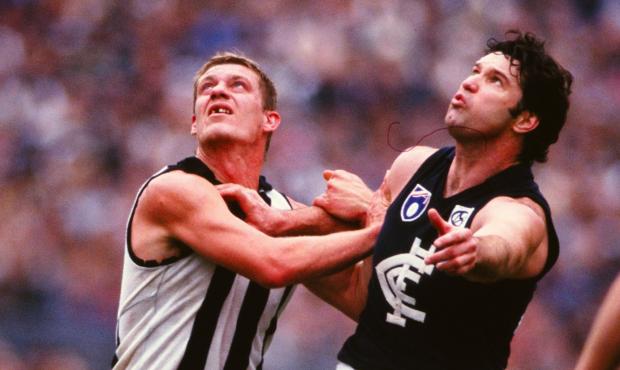The former Blue who has worked with elite-level under-18 ruckmen, has questioned whether junior giants spend enough time learning the ruck craft before entering the AFL.
And when they get there, Madden says, raw-boned talls are often not afforded the time or onfield development they need from increasingly impatient clubs.
Max Bailey, the recently retired Hawthorn premiership ruckman and now development coach at Richmond, isn't as concerned about the state of ruck play, insisting there will always be a place in the game for skilled tap-ruckmen who give their midfielders an armchair ride.
However, Bailey was wary of what the substitute rule and new interchange cap would mean for ruckmen, given the increasing demand for those who can play multiple positions.
Bailey also supports Madden's view that a ruck academy would be a great initiative.
Madden, a dual best and fairest winner, three-time All Australian and dual premiership player, was regarded as one of the last 'dinosaur' ruckmen. In recent years he has watched his son Joel play for Calder Cannons in the TAC Cup under-18 competition and helped ruckmen in the Vic Metro representative squad.
"I'd hate to see the fine art of ruckwork lost from the game, but I think there is a genuine risk of that," Madden told AFL.com.au.
Jurassic park: Damien Monkhorst and Justin Madden lock horns at the MCG in 1995. Picture: AFL Media

"Ruckwork isn’t as much of a focus for young big blokes these days because many of them are so athletic that they spend a lot of time in key positions like centre half-forward or full-forward. So by the time they get to an AFL club they don't have much actual experience as ruckmen and they haven’t learnt some tricks of the trade you need if you’re going to make it.
"Whereas big fellas in my era – particularly those like myself who lacked athleticism, coordination and a physique – were specialist ruckmen from the start and we learned how to use our bodies and protect ourselves."
Madden worries that spots on AFL playing lists have become so precious that big men are being asked to mature faster than ever before.
"You can train big fellas as much as you want but the only way they learn is by rucking against quality opponents at AFL level. And they usually don’t start to earn their stripes until they've bulked up a bit, and some won’t do that until they’re 23-24. But the system doesn’t allow clubs to persevere for long enough," he said.
Bailey is perhaps the best modern example of the benefits of perseverance and patience – his club's and his own. In a career plagued by three knee reconstructions, he played just 43 games in eight seasons.
The 27-year-old said the bulk of a ruckman's development doesn't take place at junior level but in the AFL system, revealing that he was "by no means a good ruckman" when he started with the Hawks but eventually became "adequate".
Bailey said the new rules are "certainly leaning away" from old-fashioned, lumbering big men who only play in the ruck.
"I don't necessarily think it's a bad thing that ruckmen need to get more of the ball and kick goals – if they can do it, it makes them more valuable," he told AFL.com.au. "But I'd hate to see big, strong ruckmen, who mightn't be as mobile but they're smart, missing out on playing in the AFL because of the new rules. That's my concern."
Madden enthused that a ruck academy could work wonders with players before and after they are drafted.
"I'm all for any initiative that can better prepare big blokes for the rigours of the AFL, and that would certainly help," he said.
Bailey agrees.
"It would be great," he said. "I marvel at the American college system because they spend three or four years there and they're ready to go when they get drafted. So if we can have a set-up where we can give these young guys a bit more of an advantage than they would normally get, it's got to be good for ruckmen and good for the game."
Twitter: @AFL_BenCollins



